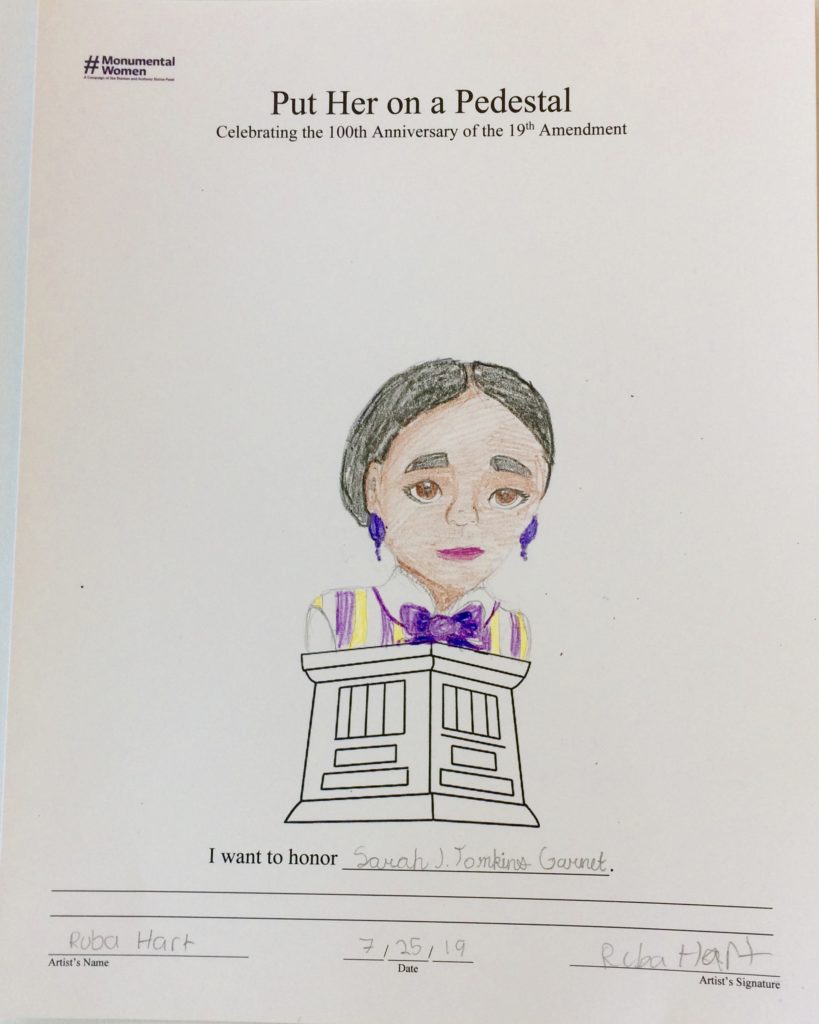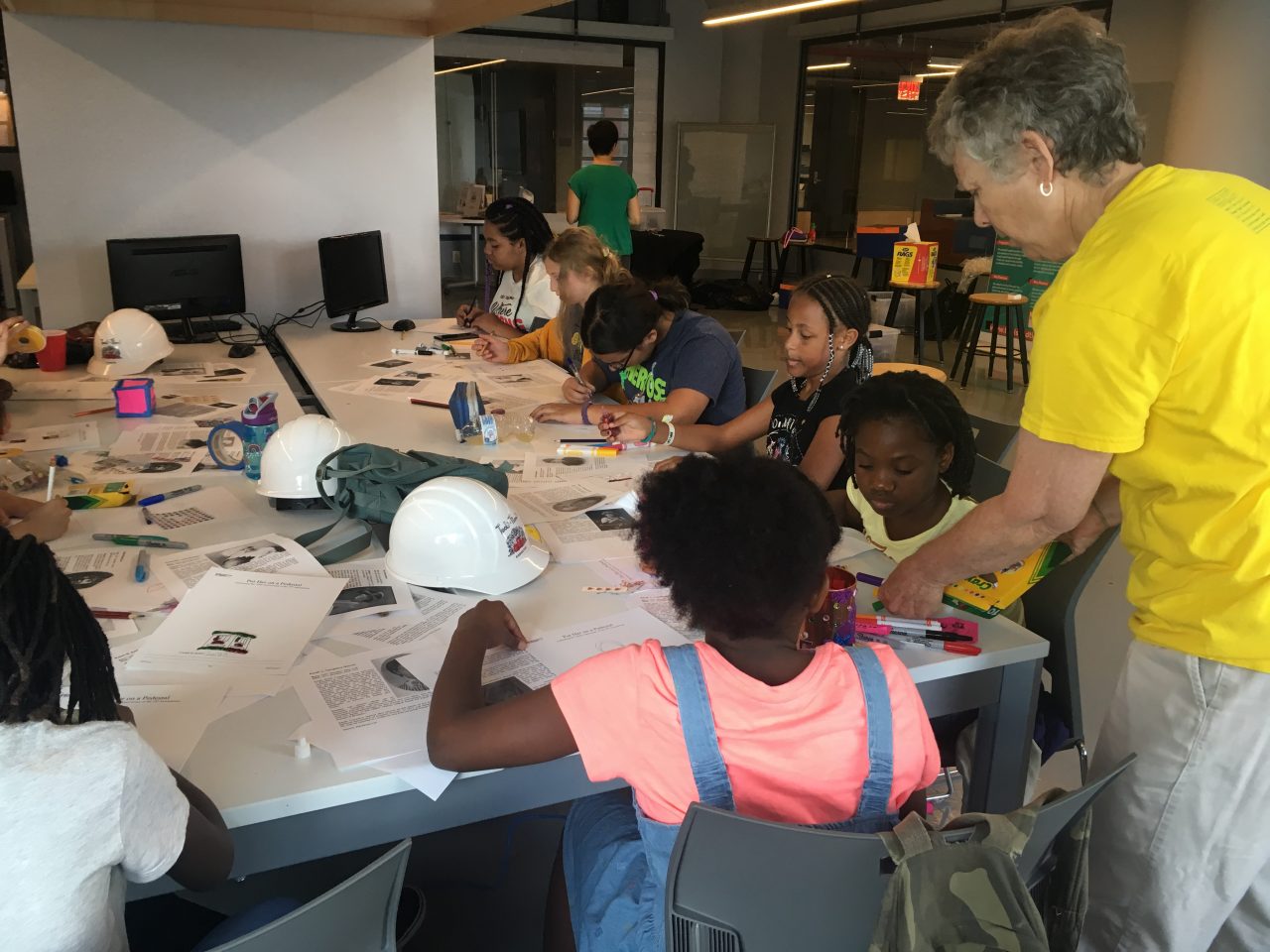Monumental Women “Put Her On A Pedestal” Art and History Project
Which woman from the past do you think deserves to be put on a pedestal? Now’s your chance to show us. Be a part of this exciting community-driven project. Learn. Draw. Share. Celebrate!
STEP 1 – Pick a Woman From the Past
Who do you want to honor? Read about the monumental NYC women from our Women’s Rights History Trail or do your own research. Ask your parents, teachers or friends for suggestions! Find someone who inspires you.
STEP 2 – Download Our Pedestal Template
This is your canvas. Bring your favorite monumental woman to life!
STEP 3 – Create Your Artwork
Get creative! Have fun while learning about and celebrating monumental women who moved history forward. Let us know why your person is so special.
STEP 4 – Upload It!
Drawings submitted to us may be selected to be featured on our website and social channels and you could win some Monumental Women merchandise!
Let’s Get Started!
1. Pick a Woman From the Past
Here’s a list to get you started.

Born: October 7, 1896, Guangzhou (Canton), China
Died: 1966, New York, NY
Quotation: “Feminists want nothing more than the equality of opportunity for women to prove their merits.” – Mabel Lee, 1914
Mabel Ping-Hua Lee learned English at a missionary school and later won an academic scholarship that granted her a US visa; the Lee family settled in New York City in 1905. At 16, Mabel Lee was already a well-known figure in New York’s suffrage circles. In 1912, Lee, on horseback, helped lead tens of thousands of New York City suffragists in a parade advocating for women’s voting rights. In 1912, Lee also began studying at Barnard College where she wrote feminist essays for The Chinese Students’ Monthly. In 1915, the Women’s Political Union started a Suffrage Shop and invited Lee to give a speech in which she urged the Chinese community to promote girls’ education and women’s civic participation. Although women were granted suffrage in 1920 with the passage of the 19th Amendment, Chinese women, like Mabel Lee, could not vote until 1943. The Chinese Exclusion Act limited Chinese immigration and prevented Chinese immigrants from becoming citizens. However, this did not deter Lee and other Chinese suffragists who advocated for women’s voting rights even though they did not benefit from the legislation. Lee went on to obtain a PhD in economics from Columbia University, becoming the first Chinese woman to do so. She later founded the Chinese Christian Center which served as a community center offering vocational and English classes, health services, and a kindergarten. Mabel Lee died in 1966 in New York City, and it is unknown if she ever became a US citizen or ever voted in the US.
Citation: National Parks Service

Born: July 31, 1831
Died: September 17, 1911
Sarah Garnet was an African American educator and suffragist from Brooklyn who was a pioneer as the first African-American woman school principal in the New York City public school system. The daughter of Sylvanus and Anne (Springsteel) Smith, Sarah was the oldest of 11 children; her parents were farmers and among the founders of the African-American community of Weeksville in Brooklyn, then part of Long Island. Her sister Susan McKinney Steward was the first African American woman in New York State to earn a medical degree, and the third in the United States. When Sarah Garnet began teaching in New York City, the public schools were racially segregated. In 1845, at the age of fourteen Garnet started working as a teacher’s assistant. Nine years later in 1854 she became a teacher at the African Free School of Williamsburg, which is now part of Brooklyn. Garnet adopted new pedagogical methods throughout her teaching career. All her hard work was recognized on April 30, 1863 when she was appointed a Principal in the New York public school system. She would oversee two public schools, Grammar School Number Four and Public School Number Eighty until she retired in 1900. She served as teacher and principal for 37 years. Throughout her career in the education system, Garnet fought to abolish race discrimination for all colored teachers, equal pay for equal work performed by woman and women’s rights. In the late 1880’s Garnet help found the Equal Suffrage League, a Brooklyn-based club for black women. The League insisted that “women had the same human intellectual and spiritual capabilities as men and that the denial of women’s right to vote in a nation that was founded on the ideal on the people’s right to rule was unjust.” In the early 1900’s, after Garnet became the superintendent of the Suffrage Department of the National Association of Colored Women (NACW), the Equal Suffrage League would become affiliated with National Association of Colored Women. Garnet along with the president of the league, Dr. Vienna Harris Morton Jones, supported the creation of the Niagara Movement, which demanded equal rights for all Americans. Her life was dedicated to teaching, not only in the classroom but also in her community.
Citation: historicalbrooklyn.wordpress.com

Born: October 23, 1881, Los Lunas, NM
Died: January 3, 1965, Santa Fe, NM
Quotation: “I will take a stand and a firm one whenever necessary, for I am with you now and always.” – Nina Otero-Warren, 1917
Nina Otero was born in Las Lunas, New Mexico, in 1881 to a prosperous family. In 1914, Otero-Warren became involved in the women’s suffrage campaign. Otero-Warren soon ascended to a leadership position in the state campaign by connecting with both Spanish and English-speaking communities. Politically connected as the niece of the former territorial governor, while she was not successful in implementing women’s suffrage in the state, Otero-Warren effectively convinced the state congressional delegation to vote for the 19th amendment in 1920. Between 1917 and 1929, Otero-Warren served as one of the state’s first female government officials, first as Santa Fe Superintendent of Instruction, and later as chair of the State Board of Health. In 1922, she ran for the U.S. House of Representatives, eventually losing. Later she was named director of the Civilian Conservation Corps for New Mexico by President Roosevelt. She led efforts to preserve historic structures in Santa Fe and Taos and strengthened the state’s relationship with the artists, writers, and intellectuals in the 1930s and 1940s. She also renewed interest and respect for Hispanic and Indian culture.
Source: Autry Women of the West Museum

Born: July 16, 1862, Holly Springs, MS
Died: March 25, 1931, Chicago, IL
Quotation: “With no sacredness of the ballot there can be no sacredness of human life itself.” – Ida B. Wells-Barnett, 1910
Born a slave in 1862, Ida B. Wells-Barnett became the most famous black woman of her age for her influence as a teacher, journalist, lecturer, author, suffragist, and social justice activist. Wells-Barnett took on discrimination and racism in many forms, ranging from her refusal to sit in the “colored” section of a Chesapeake & Ohio Railroad train car, to her crusade as a newspaperwoman and editor of the Memphis Free Speech where she documented the horrors of lynching. She sued the railroad company and challenged the persistent racism of the south in the form of lynching. After moving to Chicago, Wells-Barnet organized the Negro Fellowship League to improve her community. She challenged white suffragists and black leaders alike when she founded the Alpha Suffrage Club of Chicago which campaigned for suffrage for black women. Wells-Barnet later served as a probation officer, acted as secretary of the National Afro-American Council, founded the Cook County League of Women’s Clubs, and worked with Jane Addams to fight against school segregation. She also ran for political office. Ida B. Wells-Barnett died in 1931.
Source: Library of Congress

Born: January 11, 1885, Mount Laurel Township, NJ
Died: July 9, 1977, Moorestown, NJ
Quotation: “It is incredible to me that any woman should consider the fight for full equality won. It has just begun.” – Alice Paul, 1920
An unlikely duo, Lucy Burns, a lively Irish woman from Brooklyn, and Alice Paul, a shy Quaker from New Jersey, formed a lasting partnership that altered the trajectory of the women’s suffrage movement. They met in the United Kingdom, and when they returned to America, they brought with them a new style of nonviolent militarism which they used to go on the offensive in the American Woman Suffrage campaign. In successive campaigns in 1912, 1913 and 1916, the pair formed and led the Congressional Committee of the National American Woman Suffrage Association, the Congressional Union for Woman Suffrage, and the National Woman’s Party respectively. In these campaigns, Burns and Paul challenged both the Wilson administration as well as conservative suffragist groups. Their daring style often resulted in pain. From 1917 to 1919, Burns and Paul led members of the National Woman’s Party in picketing the White House, making them the target of mob attacks, arrest and imprisonment. After staging a hunger strike, they were beaten and force fed. However, a year later with the ratification of the 19th Amendment, their sacrifice was vindicated.
Source: Library of Congress

Born: July 28, 1879, Brooklyn, New York, NY
Died: December 22, 1966, Brooklyn, New York
Quotation: “Those who hold power are responsible not only for what they do but for what they do not do. Inaction establish just as clear a record as does a policy of open hostility.” – Lucy Burns, 1913
An unlikely duo, Lucy Burns, a lively Irish woman from Brooklyn, and Alice Paul, a shy Quaker from New Jersey, formed a lasting partnership that altered the trajectory of the women’s suffrage movement. They met in the United Kingdom, and when they returned to America, they brought with them a new style of nonviolent militarism which they used to go on the offensive in the American Woman Suffrage campaign. In successive campaigns in 1912, 1913 and 1916, the pair formed and led the Congressional Committee of the National American Woman Suffrage Association, the Congressional Union for Woman Suffrage, and the National Woman’s Party respectively. In these campaigns, Burns and Paul challenged both the Wilson administration as well as conservative suffragist groups. Their daring style often resulted in pain. From 1917 to 1919, Burns and Paul led members of the National Woman’s Party in picketing the White House, making them the target of mob attacks, arrest and imprisonment. After staging a hunger strike, they were beaten and force fed. However, a year later with the ratification of the 19th Amendment, their sacrifice was vindicated.
Source: Library of Congress

Born: February 15, 1820, Adams, Massachusetts
Died: March 13, 1906, Rochester, New York
Susan B. Anthony is perhaps the most widely known suffragist of her generation and has become an icon of the woman’s suffrage movement. Anthony traveled the country to give speeches, circulate petitions, and organize local women’s rights organizations. Anthony was born in Adams, Massachusetts. After the Anthony family moved to Rochester, New York, they became active in the antislavery movement. Antislavery Quakers met at the Anthony farm almost every Sunday, where they were sometimes joined by Frederick Douglass and William Lloyd Garrison. In 1848 Susan B. Anthony was working as a teacher when she discovered that male teachers were paid a monthly salary of $10.00, while the female teachers earned only $2.50 a month. She worked for equal pay for women from that moment on. Anthony also worked to oppose slavery and organized in support of the Temperance Movement. Anthony met Elizabeth Cady Stanton in 1851, the beginning of a long friendship and working relationship in women’s rights reform. Anthony was often a guest in Stanton’s home, along with Sojourner Truth and many other reformers. In 1863 Anthony and Stanton founded the Women’s Loyal National League in New York City. In 1868 they helped found the American Equal Rights Association. From 1868 – 1870 Anthony and Stanton wrote and published their newspaper, The Revolution. They founded the National Woman Suffrage Association in 1869. In 1872, Anthony was arrested for voting in the presidential election, an action which was illegal because of her gender. At her trial, the judge directed the all-male jury to find her guilty. From 1881 to 1885, Anthony joined Elizabeth Cady Stanton and Matilda Joslyn Gage in writing the History of Woman Suffrage. As a tribute to Susan B. Anthony, the Nineteenth Amendment prohibiting the right to vote from being denied by states or the federal government on account of sex was named the Susan B. Anthony Amendment. The Nineteenth Amendment was enacted in 1920.
Source: National Park Service

Born: 1797, Rifton, NY
Died: November 26, 1883, Battle Creek, MI
Quotation: “We’ll have our rights, see if we don’t; and you can’t stop us from them, see if you can.” – Sojourner Truth, 1853
Born a slave in 1797, Isabella Baumfree, later Sojourner Truth, became one of the most powerful advocates for human rights in the nineteenth century. She spent her early life on a New York estate owned by a Dutch American named Colonel Johannes Hardenbergh where she experienced the horrors of slavery. After her master refused to free her under the New York Anti-Slavery Law of 1927, Isabella ran away. Following a religious conversion in 1843, Isabella became a preacher and in 1843 changed her name to Sojourner Truth. Growing out of her participation in the antislavery movement, Sojourner Truth became increasingly involved in the women’s rights movement. At the 1851 Women’s Rights Convention in Akron, Ohio, she delivered her famous “Ain’t I a Woman?” speech. She continued to speak out for the rights of African Americans and women both during and after the Civil War and until her death in 1883 in Battle Creek, Michigan.
Source: National Women’s Rights Historical Park

Born: November 12, 1815, Johnstown, New York
Died: October 26, 1902, New York, New York
Elizabeth Cady Stanton’s Declaration of Sentiments, which she presented at the 1848 Seneca Falls Convention, is often credited with initiating the women’s rights and Woman Suffrage movements in the United States. Her civil rights activism began with the abolitionist, anti-slavery movement. She attended the World Anti-Slavery Convention in London in 1840, where women were at first refused admission. After much debate, women were allowed to sit in the balcony, but not to participate. That convention was where Stanton met the famous reformer Lucretia Mott, and they both vowed to hold a convention in the United States to discuss the injustices against women. Together with Mott’s sister Martha Coffin Wright, Jane Hunt and Mary Ann McClintock, they organized the Seneca Falls Convention held on July 19 and 20 of 1848. While it was not the first meeting in support of women’s rights, New York’s Seneca Falls Convention was later credited by suffragists and historians as the meeting that launched the suffrage movement. Stanton met Susan B. Anthony in 1851, the beginning of a long friendship and working relationship in women’s rights reform. Despite the demands of her large family, and often with the help of Anthony, Stanton opened her home to those traveling and advocating for equal rights for women, calling it “The Center of the Rebellion.” She hosted Anthony, Sojourner Truth and other suffragists. In 1863 Stanton and Anthony founded the Women’s Loyal National League in New York City. In 1866 Stanton was the first woman to run for Congress in what was then New York City’s Eighth Congressional District. In 1868 Stanton and Anthony helped found the American Equal Rights Association, and from 1868–1870 they wrote and published their own newspaper, The Revolution. Stanton and Anthony founded the National Woman Suffrage Association in 1869. Along with Matilda Joslyn Gage, they also co-authored the History of Woman Suffrage. Though ill health restricted Stanton’s travel in later life, she continued to write and publish books and articles on women’s rights until her death in 1902.
Source: National Park Service

Born: January 13, 1810, Piotrków Trybunalski, Poland
Died: August 4, 1892, Brighton, United Kingdom
Quotation: “Here lies the corner stone of all the injustices done woman, the wrong idea from which all other wrongs proceed. She is not acknowledged as mistress of herself. From her cradle to her grave she is another’s. We need and demand the other rights, but let us first obtain ourselves.” – Ernestine Rose, 1853
Born in 1810 in the Polish ghetto to the town rabbi and his wife, Ernestine Rose received a better education than was typical for Jewish girls of that time and place. However, by the age of 14, Ernestine Rose rejected the Jewish customs that relegated women to an inferior status, and she renounced her Jewish faith. By the age of 21, Ernestine Rose settled in England, and she eventually married William E. Rose in 1836. The couple soon immigrated to the United States where Rose’s drive for equal rights for women gained greater momentum. Strongly opposed the law that deprived married women of the right to control property they had owned before marriage, she led a campaign in New York to reverse that law in the 1840s. Her work was vindicated in 1848 when the New York State reversed the law. By the 1850s, Rose grew in prominence in the women’s rights movement, advocating for abolition and temperance, as well as women’s rights. With Susan B. Anthony and Elizabeth Cady Stanton, she co-founded the National Woman Suffrage Association aimed at securing a constitutional amendment granting women the right to vote.
Source: Encyclopaedia Britannica
2. Download Our Template (or use a plain white piece of paper)
3. Create Your Artwork
When you’re finished with your drawing, make sure to write in her name, your name, the date and sign your signature. See some examples below.





4. Upload It
